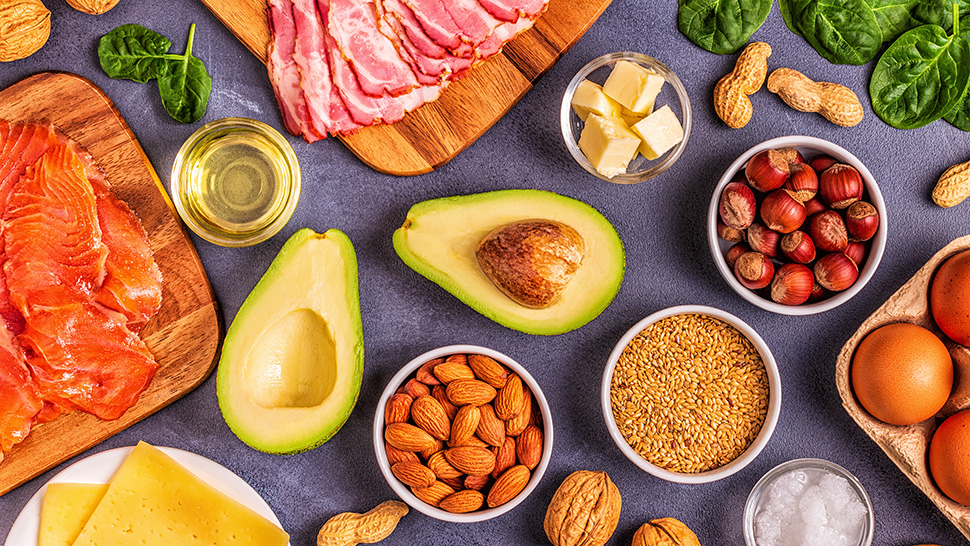
Once a diet used primarily in clinical settings as part of a treatment plan for children with epilepsy, the ketogenic diet (aka “keto”) has become mainstream for tackling anything from weight loss to migraines. If you’re thinking of going “keto,” here’s what you’ll want to know before you start.
What is the ketogenic diet?
It’s a high fat, very low carb, low-to-moderate protein diet. A standard ketogenic diet contains between 75-80% fat, 15-20% protein, and 5% carbohydrate. For the average person, that means limiting carbohydrate intake to about 25 grams per day, or the amount found in a medium apple.
By significantly limiting carbohydrate intake, your body adapts to using fat for energy putting your body into a state called ketosis (hence the name ketogenic diet). When producing energy from fat, the liver also creates ketones, which the brain can use for energy. To maintain ketosis, it’s important to not only limit carb intake, but also protein intake as the body can turn protein into glucose (the simplest form of carbohydrates) for energy and will preferentially do so if protein intake is in excess of what the body needs.
There are other versions of the ketogenic diet such as the cyclical ketogenic diet (CKD), targeted ketogenic diet (TKD), high-protein ketogenic diet, and ketogenic diet “lite” (a.k.a. lazy keto). The CKD includes five days on the standard keto protocol followed by two high carb days. The TKD allows for higher carb intake around workouts. Both of these are often used by athletes hoping to train the body to use fat for fuel over carbs. The higher protein version of the diet allows for up to 35% protein and 60% fat, while still keeping carbs at 5%. This diet has been shown to be less effective at achieving fat loss and other benefits of the ketogenic diet as ketosis is often not maintained because protein is converted to glucose for energy. Ketogenic lite shifts the focus onto carbohydrate intake, with a goal of less than 20 grams per day, and has no strict rules around protein or fat. It allows individuals to spend less time counting their macros, but is less likely to result in long-term ketosis.
What can I eat?
To achieve ketosis, you’ll need to eat mostly high-fat foods including avocado, oils, cheese, cream, butter, nuts, and seeds. Fatty cuts of meat and poultry, eggs, and fatty fish are encouraged for protein sources. Full-fat dairy is allowed in moderation (all dairy contains some carbohydrates). Non-starchy vegetables are also a staple of this diet.
What is off limits?
While there is no single food that is technically off limits, to achieve ketosis, you’ll want to avoid all grains, including bread, pasta, and whole grains; beans and legumes; fruit; starchy vegetables; foods that contain sugar; alcohol; and most jarred condiments as they often contain sugar.
Is there anything else to consider?
The ketogenic diet requires commitment. It’s well known in the keto community that you can experience what’s referred to as the keto flu — or feelings of illness and fatigue — in the early stages, but once your body adapts, you will likely regain your energy as long as you push through those tough days or weeks. Some people who follow an active lifestyle find the adaptation period to be challenging because of the low energy. While some high level endurance athletes have realized performance benefits, most people find that it reduces performance overall.
The restrictive nature of the diet can be challenging for some to stick to the plan, especially in social situations and eating out of the home, so you’ll want to think about how this diet may or may not fit into your current lifestyle.
If you want to know the science…
Weight loss
Short-term research has shown that people do lose weight on this diet — and quickly. The first several pounds are often water weight. As the body uses up any stored carbohydrates, there is a significant loss of water because for every one gram of stored carbohydrate, you store three grams of water. After that initial water loss, it can still be an effective weight loss diet if you can stick to it. However, other research has concluded that low-fat, high-carb and low-carb, high-fat diets lead to similar weight loss results.
Diabetes and heart health
Very small, short-term studies have shown some promise in improving blood sugar control among people with Type 2 diabetes, but more research is needed to determine whether or not it should be a recommended diet for diabetes treatment. The research on the ketogenic diet and heart health is conflicting. Some small studies suggest an improvement in cholesterol and triglycerides whereas others have shown that the diet has a negative impact on cholesterol. Many health professionals are concerned about the very high fat nature of the diet, especially if most of the fat comes from animal sources, but more research is needed to determine whether it’s actually a concern for heart health.
Neurological diseases and the brain
Preliminary studies have shown some promise when it comes to slowing the symptoms of both Alzheimer’s and Parkinsons on a ketogenic style diet, but more human research is needed as much of the initial research has been done with animals. It’s hypothesized based on clinical experience that the ketogenic diet may help people with severe migraines, but no clinical trials have been conducted yet.
Disclaimer: The information in this article is not intended to be medical advice and if you are considering starting a new diet, work with your healthcare team to find the best approach for you.
Read about other popular diets in this series: